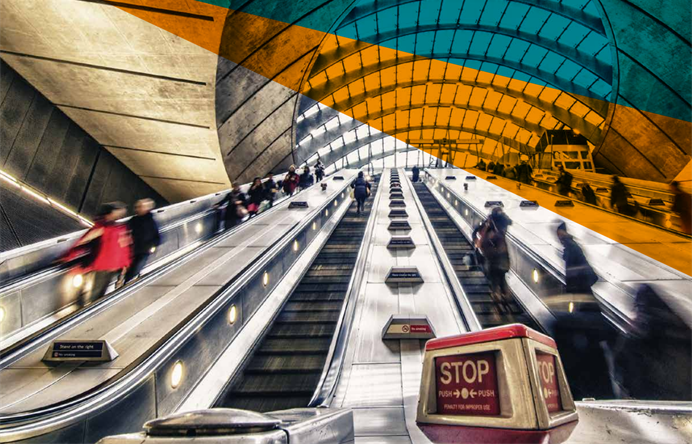
Disabled people in the UK make 38% fewer journeys than non-disabled people — a figure that’s barely shifted in over a decade. This sustained Transport Accessibility Gap reveals systemic inequalities in mobility and social inclusion. To challenge this, the Motability Foundation funds vital research into inclusive transport systems, supporting disabled researchers, like myself, through a funded PhD in partnership with The Open University. My project centres around a key research question: “How can transport hubs be made more accessible for disabled individuals by design?” My work aims to elevate the lived experiences of disabled travellers and inform inclusive, experience-led approaches to the design of transport environments.
This study draws inspiration from Strickfaden & Devlieger’s (2011; 2012) ethnographic research with metro users. They identified sensory and navigational barriers and revealed how design often wrongly assumes disabled people don’t seek independence. Through co-design, disabled participants became research instruments themselves—offering tactile, spatial, and embodied insights that shaped better design. The process was iterative, empowering, and inclusive. Their study also explored important design concepts such as immateriality (felt experience), nonplaces (alienating transitional spaces), and metro-time (the temporality of waiting). Similarly, Harding et al. (2016) employed autoethnographic video diaries and interviews to reveal the nuanced experiences of disabled travellers at Canary Wharf. Their findings emphasised the value of including researchers with lived experience—who occupy a dual role as insider (disabled participant) and outsider (researcher). This positionality fosters empathy while maintaining critical perspective. They also advocate for the use of immersive techniques, simulations, and mobile methodologies to understand the complexities of station design and multi-modal transitions. Their call for more empirical studies across diverse urban environments and varied transport hubs continues to shape my evolving methodological approach.
Imagine feeling invisible—or even endangered—during every journey. In Norway, a case study uncovered how inaccessible transitions, confusing signage, and overwhelming sensory stimuli created chronic travel stress, especially at intermodal hubs (Øksenholt & Aarhaug, 2018). In Australia, Wayland et al. (2022) found that fluctuating visibility of disability led to discriminatory behaviour and unpredictable assistance. In the UK, a survey revealed how bus drivers’ assumptions about invisible impairments resulted in passengers being refused access, especially those with neurodivergent conditions (Das Neves et al., 2023). The urban environment also poses threats: Lawson et al. (2022) highlighted how e-scooter clutter endangers users with sensory or mobility impairments, while Jacobs & Dhaliwal (2024) examined how the sudden e-scooter ban in Toronto exposed the absence of accessibility awareness in micromobility planning. Public toilets, meanwhile, are a recurring site of anxiety: Mathews et al. (2022) explored the impact of unsafe and inadequate toilet access on disabled, neurodivergent, and chronically ill people, and Slater & Jones (2021) examined how toilet inaccessibility reinforces structural inequality, especially for trans and disabled users.
Across the literature, new methods—from participatory photography and video ethnography to AI, simulation and AR-enhanced storytelling—are being adopted to elicit lived experience. These approaches not only improve design but also redistribute expertise in research, helping reframe disabled people as knowledge producers rather than subjects of study.
Das Neves, B., Unsworth, C., & Browning, C. (2023). ‘Being treated like an actual person’: attitudinal accessibility on the bus. Mobilities, 18(3), 425–444. https://doi.org/10.1080/17450101.2022.2126794
Harding, J. E., Luck, R., & Dalton, N. (2016). Journeys in the City: Empathising With the Users of Transport Buildings. https://oro.open.ac.uk/55427/
Jacobs, L., & Dhaliwal, H. (2024). Disabled Pedestrians, Micromobility, and Furthering Disability Equality Law through Consultation: A Case Study of the Toronto E-Scooter Ban. Laws, 13(52). https://doi.org/10.3390/laws13040052
Lawson, A., Eskytė, I., Orchard, M., Houtzager, D., & De Vos, E. L. (2022). Pedestrians with Disabilities and Town and City Streets: From Shared to Inclusive Space? The Journal of Public Space, 7(2), 41–62. https://doi.org/10.32891/jps.v7i2.1603
Mathews, G., Marshall, M., & Wilkinson, H. (2022). A public inconvenience: better toilets for inclusive travel. Disability and Society, 37(7), 1146–1172. https://doi.org/10.1080/09687599.2020.1867508
Motability Foundation. (2022). The Transport Accessibility Gap. https://www.motabilityfoundation.org.uk/media/iwaidhxk/motability_transport-accessibility-gap-report_march-2022_final.pdf
Øksenholt, K. V., & Aarhaug, J. (2018). Public transport and people with impairments–exploring non-use of public transport through the case of Oslo, Norway. Disability and Society, 33(8), 1280–1302. https://doi.org/10.1080/09687599.2018.1481015
Slater, J., & Jones, C. (2021). Toilet Signs as Border Markers: Exploring Disabled People’s Access to Space. International Journal of Disability and Social Justice, 1(1), 50–72. https://doi.org/10.13169/intljofdissocjus.1.1.0050
Strickfaden, M., & Devlieger, P. (2011). Empathy through Accumulating Techné: Designing an Accessible Metro. Design Journal, 14(2), 207–230. https://doi.org/10.2752/175630611X12984592780041
Wayland, S., Newland, J., Gill-Atkinson, L., Vaughan, C., Emerson, E., & Llewellyn, G. (2022). I had every right to be there: discriminatory acts towards young people with disabilities on public transport. Disability and Society, 37(2), 296–319. https://doi.org/10.1080/09687599.2020.1822784

Leave a Reply